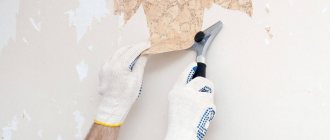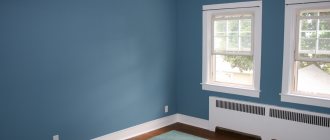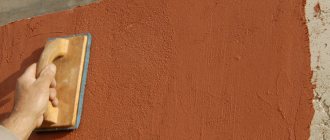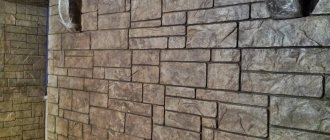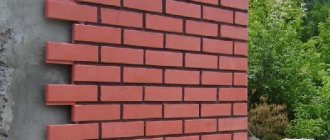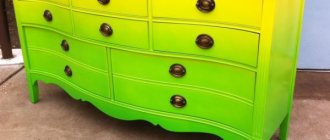How to get rid of paint stains on windows?
Use a solvent appropriate for the type of paint when cleaning glass. Plastic is more difficult to clean - it is vulnerable to solvents. Water-based paint can be removed with hot water. It is sprayed, then the stains are removed with a scraper. Turpentine helps get rid of other coloring compounds. Do not clean surfaces with blades or iron spatulas to avoid scratching them.
- Fresh oil paint on PVC can be removed with White Spirit or Solvent, while dried paint can be removed with a cermet scraper. The glass is cleaned with a blade.
- Fresh water-based paint (with acrylic, latex) is removed with a soap solution, dried - with a spatula. With some effort, using a soapy solution and a stiff brush, you can scrub off even old water-based emulsion stains.
Thermal removal
This method is intended for professionals, as appropriate equipment may be required. The principle of the technique is to preheat the coating using a special machine. At home, this could be a gas burner. However, it causes an unpleasant odor.
Using a thermal method to remove water-based paint Source roomester.ru
Types of dyes and disposal methods
Having dealt with the main issue regarding leather, we can begin to consider the types of dyes and methods for their removal:
- Let's start with acrylic, since this dye is often used both in the interior and in finishing work on the facade. If paint gets on the fabric and it is possible to immediately begin removing it, then before washing the acrylic paint you will need simple soap. As long as the material has not saturated the fabric, it can be easily removed.
- If you were unable to wash your clothes right away, then later you can add a small amount of baking soda or vinegar to the water in which everything is washed, whichever is closer to hand.
You can wash off the paint with soap immediately after it gets on the fabric.
- Besides soap and water, you will have to think carefully about how to wash acrylic paint when the dye dries on the fabric or surface. In this case, a special wash will be required. Here it is important to purchase the remover in the same place where you bought the paint; this is an ideal way to obtain the necessary composition for a certain type of paint.
- If we are talking about clothing, then after the remover is applied to it, the product should remain on the fabric for several minutes; details of this are always indicated in the instructions for use.
Advice! Since the wash often has a rather pungent and specific odor, it is recommended to wash the clothes in hot water, which will help eliminate the odor.
Water emulsion
The leader among all paint and varnish materials in terms of use in indoor work is water-based paint. And naturally, you need to know how to wash water-based paint, since during the painting process it will definitely get on clothes, on open areas of the body, and on surfaces in the room.
Especially when working with the ceiling, the water emulsion can end up “everywhere”
In this case, there is absolutely nothing difficult about washing everything off with your own hands. Water-based paint is interesting because its very name answers many questions. Being a water-based dye, this paint is easily washed off with water and soap from clothes or just water and a sponge from surfaces.
For example, if a dye gets on any material, it is washed off with water, because water does not cause a chemical reaction of annihilation on plastic, ceramics, or wood.
Facade
Facade paint can be based on water-based emulsion or acrylic, silicate, latex. The latter, unlike water emulsion, are, of course, more common. And all of them can be easily washed off with simple washes and solvents.
However, before you wash the façade paint, you need to purchase a solvent of the exact type that matches the type of façade paint. Plus, there is a moment when the paintwork gets on the plastic window sills. Not every solvent is suitable for working with plastic; some chemical compounds can only damage the material.
How to remove water-dispersion paint
Have you painted a surface, splashed paint past the area being painted, and don’t know how to wash off the water-dispersion paint so that the surface under the stain is not damaged? Already from the name of the paint it is clear that its diluent or solvent is plain water, therefore it is also washed off or washed off with plain water.
Water-dispersion paint is a coating that is produced by manufacturers of paints and paintwork materials (LCMs) based on synthetic binders (for example, these can be resin or petroleum polymers). This type of paint is considered the most environmentally friendly and fireproof among other paintwork materials, because in fact it is diluted not with special solvents developed specifically for this purpose, but with plain water, therefore there is much less harm from it than from solvent-based paints.
You can also wash off water-dispersion paint from paint tools, for example, from brushes and rollers used in your work, with plain water. Water is essentially the solvent of this paint.
How and how to remove water-dispersion paint
How and how to remove water-dispersion paint from various currently painted and unpainted surfaces, such as walls, doors, windows, or even surfaces such as home furniture? For example, you were painting and painting the walls, but accidentally blurted out on the door or vice versa, or the paint fell on the floor while painting the ceilings. What to do now? Water-based paints use ordinary water as a solvent, so it is obvious that you need to wash it with water and a brush.
How can you quickly and fairly carefully and accurately remove excess paint, for example, which is very important, without damaging the tinting of wooden doors during the process of washing off this material, while maintaining the tinting in its original form. If the water-dispersion paint with which you painted the surface does not belong to the category of very durable and washable, then it can be carefully and carefully washed off with a clean damp cloth or a slightly dampened old waste towel. Just wipe the surface with it, just do not overdo this process so as not to damage the tint.
If the paint stain is still relatively fresh, you can try to remove it with plain water, cold or warm. But this needs to be done on a fresh stain, while the paint has not yet hardened. But if you blurted out waterproof paint (and it is more difficult to remove), then before cleaning them you should put a clean, damp cloth on the stains for just a few hours (during this time the paint will swell well from the water, absorbing all the water that is around the stain and so blurred the paint stain will be much easier to remove from the surface you are working on). But if this simple and effective trick does not help, you will need to select a special solvent for cleaning that will help deal with such a problem quickly and at the same time quite accurately.
How to remove water-dispersion paint from laminate and linoleum
- How to wash off water-dispersion paint from laminate and linoleum: you can first experiment using a fairly simple method, but it requires maximum care. You need to very carefully remove, or rather, scrape off the paint stain, carefully prying it up with a spatula and gently scraping it, and then immediately carefully wipe off the remaining stain with a damp cloth. Just be careful - do not pierce the laminate with the sharp end of the tool and do not leave scratches or cuts on it.
- If your laminate flooring is very good (quite dense and durable), then you can even try to literally scrape it off with a brush with soft (non-metallic) bristles, as they say, but again, you should do this as carefully as possible.
- You can wipe the stain with a dishwashing sponge, rubbing the stain with its hard abrasive side (you cannot use metal brushes for this - you can severely scratch the surface of the laminate with such tools).
- You can also place a damp cloth on the stain to be wiped off for a while (just not for a very long time), and then remove the paint with a clean cloth or a clean new sponge. You just need to be very careful that the floor covered with laminate or linoleum does not get too wet during this cleaning process, otherwise it will swell and you will have to change it, and replacing any floor covering now is quite expensive in terms of money and time.
- You can try washing it again with regular warm water. By the way, it is much easier to wash off stains of water-dispersion paint from linoleum than from laminate, because linoleum has a smooth surface and removing various stains from it is always easier and faster than from rough surfaces.
What and how to wash
There is no need to spend money on expensive specialized products. Homemade and industrial soap-based products are safe for coating. It is acceptable to use dishwashing gels, glass sprays, etc. If you clean regularly, a simple flannel rag and clean water will be enough.
How to wash paint:
- Wipe away dust and dirt with a dry, then damp cloth.
- Spray the cleaning solution over the surface or spread it with a soft sponge.
- Rub with gentle movements until any remaining dirt comes off.
- Rinse off the soapy water and dirt.
- Finish washing with a clean damp cloth.
- Try removing greasy and old stains with a 1:1 alcohol solution.
There are only two things that façade paint is afraid of:
- Solvents (acetone, various removers). Water-based varieties are especially sensitive to aggressive compounds.
- Abrazivov. You should not even use fine abrasive powders and pastes, as well as hard brushes and iron sponges - you will scratch the coating.
Tip from Miss Clean magazine: Use high-gloss furniture polishes. It is enough to apply the product a couple of times a year and restore the shine of the paint.
To prevent the façade from deteriorating, wipe it with a dry and damp cloth at least once every one to two weeks.
Most painting work results in paint remaining on clothes, walls, ceilings, windows and other surfaces and objects. Even the most experienced painter is not immune from this. In addition, contact of paints and varnishes with exposed skin or hair can lead to allergies, for example.
Therefore, the question of how to remove paint from any surface and any type always remains relevant.
Photo of paint that needs to be washed off
Soap solution
To effectively remove water-based emulsion stains on a hard surface, you can use a soap solution. To prepare it:
- Take a basin and fill it with 3 liters of warm water.
- Place a bar of solid soap there and wait for it to completely dissolve.
- stir until a smooth white consistency is obtained.
- soak a sponge in the product and wipe the contaminated surface with it.
In case you were unable to remove the paint stain the first time, try making the solution more concentrated: place two bars of soap in the same amount of water. The composition can be left on the stain for 15-20 minutes for deep removal.
Soap solution for cleaning water-based emulsion stains Source posudaguide.ru
Variety of ways
We can immediately say that there is no one, universal way to wash off paint and varnish material. The reason for this is that each material has its own unique chemical composition, its own physical characteristics, which is why there are so many cleaning methods.
From hand
And the first method that you should pay attention to is how to wash your hands of paint, because they are the ones who most often get dirty. (See also the article Finishing with decorative plaster: features.)
Considering that the skin of the hands is insensitive to various chemicals, you can use several methods, for example:
- Oil dye can be easily removed using a cloth that has been pre-moistened in vegetable oil.
- To the question of how to wash water-based paint, an excellent answer is given by simple laundry soap, which easily removes water-based enamel.
Simple soap can solve many problems with water-based stains
- Other types of dyes will require chemical solvents, but the safest is white spirit.
- Another solvent is represented by anocytone-free liquid, which is used to remove nail polish; its price is low and it acts quickly.
The most skin-friendly solvent
Important! Do not get carried away with chemical solvents; excessive use can lead to an allergic reaction, not to mention simple irritation. Therefore, it is recommended to interrupt the removal process and simply wet the surface of your hands with water.
In principle, by answering the question of how to remove paint from your hands, you can get a universal answer to contamination of other parts of the body. The only thing is that if the dye gets on the skin of your face, you should be extremely careful when removing it so as not to get the solvent into your eyes. A burn to the mucous membrane can be fraught with serious health problems.
Is it possible to wash façade paint?
Facade paint has increased resistance to the vagaries of weather. This is a coating with good adhesion, water resistance, and durability. Facade paint, of course, can be washed and even watered with a hose - after all, it is intended to additionally protect walls from rain moisture and snow. The question is which products can be used for washing, and which ones are best put aside.
